Sony’s QD-OLED, reviewed here in the XR-55A95K, is a new era for OLED TV technology that’s simply stunning. Here’s why
When you purchase through links on our site, we may earn an affiliate commission.Here’s how it works.
(Image credit: Sony)

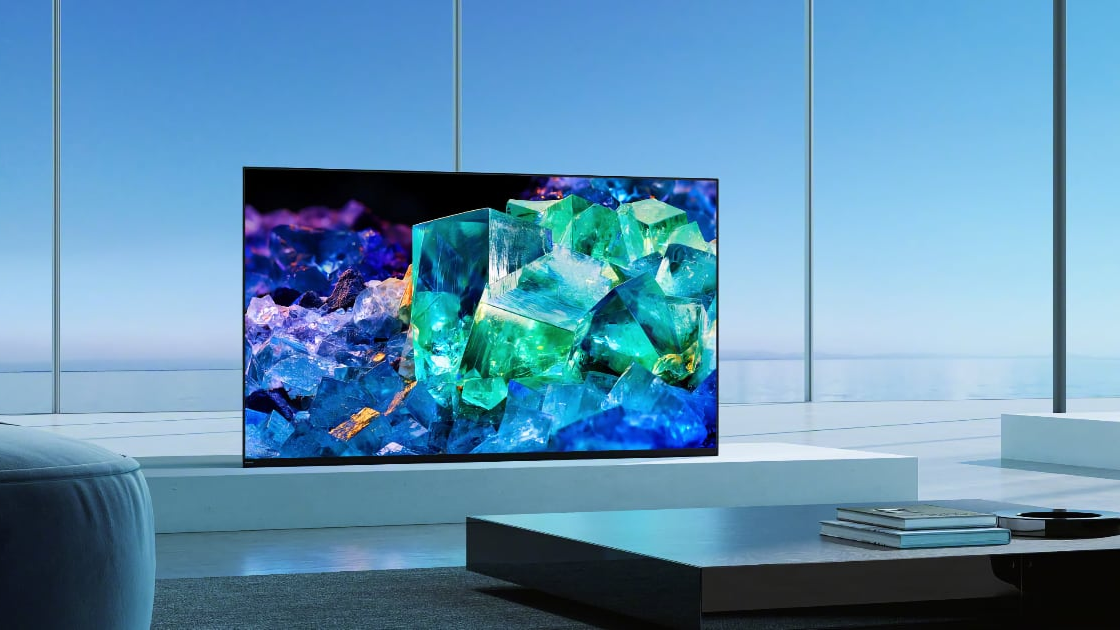
(Image credit: Sony)
T3 Verdict
Reasons to buy+Beautifully dynamic and vibrant pictures+Excellent sound quality+Distinctive and adjustable design+Supports most of the latest gaming features+Content-rich smart system
Beautifully dynamic and vibrant pictures
Excellent sound quality
Distinctive and adjustable design
Supports most of the latest gaming features
Content-rich smart system
Can lose black level in bright light
Only two HDMIs support 4K/120Hz
Google TV interface can be confusing
Why you can trust T3Our expert reviewers spend hours testing and comparing products and services so you can choose the best for you.Find out more about how we test.
Why you can trust T3Our expert reviewers spend hours testing and comparing products and services so you can choose the best for you.Find out more about how we test.
Finally, as we’re about to show in this review, while Samsung perhaps used its QD-OLED debutantes as a stick to aggressively beat regular OLED TVs with, Sony has used its A95Ks to offer a new level of refinement and picture quality aimed squarely at the discerning home cinephile. So is the A95K the best QD-OLED TV to buy right now?
Sony A95K: Price & Availability
(Image credit: Future)
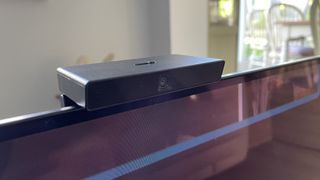
(Image credit: Future)
The 55-inch Sony A95K (that’s the XR-55A95K for the full code) is available for £2,199 in the UK, $2,399 in the US, and $AUD4,799 in Australia. This puts it at a clear premium over Sony’s other OLED and LCD TVs, as well as most premium regular ‘WOLED’ TVs. Even LG’s super-impressive OLED G2 only costs £1,599 at the time of writing.
This simply reflects Sony’s belief, though, that Quantum Dot OLED technology offers a performance benefit over regular OLED TVs or even Mini LED LCD TVs that consumers should be prepared to pay a premium to own. Where things get more difficult for the A95K on the price front is that Samsung is currently selling its S95B QD OLED TV for just £1,499. The Sony is much pricier for now.
This aggressive pricing may well be part of Samsung’s ongoing battle to try and see off the WOLED threat from its great rival LG Electronics, but facts are facts and numbers are numbers, and if the A95K doesn’t score a significant performance advantage over Samsung’s QD-OLED model, its price hike will look troublesome to say the least.
Today’s best Sony A95K QD-OLED TV, Sony KD-55A95K and Sony KD-65A95K deals56 Amazon customer reviews☆☆☆☆☆$2,498ViewLow Stock$2,798View$2,799ViewShow More DealsWe check over 250 million products every day for the best prices
Today’s best Sony A95K QD-OLED TV, Sony KD-55A95K and Sony KD-65A95K deals56 Amazon customer reviews☆☆☆☆☆$2,498ViewLow Stock$2,798View$2,799ViewShow More DealsWe check over 250 million products every day for the best prices
Today’s best Sony A95K QD-OLED TV, Sony KD-55A95K and Sony KD-65A95K deals
56 Amazon customer reviews☆☆☆☆☆
56 Amazon customer reviews☆☆☆☆☆
☆☆☆☆☆
$2,498ViewLow Stock$2,798View$2,799View
$2,498View
$2,498View
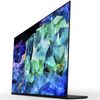

$2,498View
$2,498
$2,498
Low Stock$2,798View
Low Stock
Low Stock
Low Stock
Low Stock
Low Stock
$2,798View


$2,798View
$2,798
$2,798
$2,799View
$2,799View



$2,799View
$2,799
$2,799
Show More Deals
Show More Deals
We check over 250 million products every day for the best prices
We check over 250 million products every day for the best prices
Sony A95K review: Features & What’s New?
(Image credit: Future)
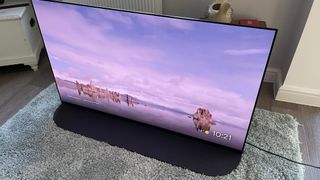
(Image credit: Future)
At this point it’s probably high time we actually got to the bottom of what all this talk ofQuantum Dot OLED actually means. The way it differs from regular WOLED (also known as WRGB OLED), is that it uses a blue phosphor element to produce each individual pixel’s light, with this blue emission then being passed through green and redQuantum Dot layersof the sort previously only found in the LCD TV world to create a pure RGB picture.
This has two potential benefits. First, it should enable more brightness. Second – and perhaps most importantly – not having to use a white element to boost the image’s brightness like traditional WOLED displays should unlock a wider, richer colour palette. Indeed, Samsung has long cited OLED’s issues with delivering affordably a pure RGB picture as one of its main reasons for leaving OLED technology alone after an early, expensive pure RGB stab at it a decade or so ago.
There are also elements of the Cognitive processor, devoted to noise reduction, enhanced upscaling of HD sources, more refined colour reproduction and, of course, Sony’s famously reliable motion processing.
As with regular OLED TVs, the A95K’s Quantum Dot OLED screen supports much wider viewing angles without any picture quality being lost than LCD TVs, and having every pixel able to produce its own light opens the door to levels of local contrast, colour shading and shadow detail that not even Mini LED TVs can match.
As with Sony’s ‘conventional’ OLED TVs, which continue lower down the brand’s range, the A95K eschews conventional speakers in favour of Acoustic Surface Audio+ technology, where the actual screen surface is used to produce sound. The advantages of this are that the sound propagates forward towards you for a punchier, more room-filling effect, so it’s possible to place specific spot effects on the screen much more accurately.
(Image credit: Future)
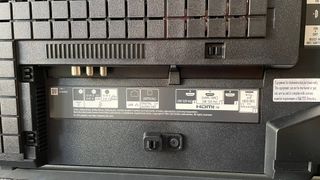
(Image credit: Future)
Other connections include four HDMIs and three USBs, with two of the HDMIs capable of handling thelatest 4K/120Hzandvariable refresh rate (VRR)gaming features.
Gamers will likely be reasonably happy, though, with the A95K’s measured input lag time in its Game mode coming in at a very respectable 16.5ms.
It’s worth adding that Sony also provides the YouView app on the A95K to cover Google TV’s blind spot when it comes to some of the UK’s terrestrial broadcaster catch-up apps.
One last notable feature of the A95K is the BraviaCam that ships with the TV. This can be attached via a simple magnetic connection point on the back of the TV’s upper edge, and opens up not just the potential for video calls but also a potentially superior viewing experience since the camera can be used to figure out where you’re sat in relation to the screen and subtly adjust the sound and picture output accordingly.
Sony A95K review: Picture quality
(Image credit: Future)
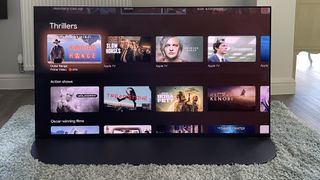
(Image credit: Future)
So does the A95K live up to the QD-OLED picture quality hype? The short answer is yes, to the extent that it arguably delivers the best all-round picture quality we’ve seen from a TV to date. Though the longer answer involves a couple of minor qualifications.
Brightness is slightly up over the best regular OLED TVs, peaking at 1020 nits (though this does drop off quite quickly). This is enough to matter – especially when it comes to the sort of small peak brightness areas that contribute so much to an authentic high dynamic range experience. Especially given that the A95K’s intense peaks are able to exist right alongside – as in, just a pixel away – from a shot’s deepest, darkest black colours, without either the bright or dark pixels compromising each other. A gorgeous reminder that the expanded light range of HDR is as much about the dark depths as the bright peaks.
To be clear, though, the amount of light required to cause this greyness on the A95K is higher than anything you’d find in a typical living room environment –and when you’ve got that much light in your room, you probably won’t notice a drop off in black level performance as much anyway.
While it’s good to see the A95K nerdling a touch more brightness out of a self-emissive screen technology than we’ve seen before, its real secret weapon is its colour performance. Rich tones – especially reds and yellows – enjoy a level of vibrancy, volume and purity beyond anything we’ve seen before on any other self-emissive TV technology. And they achieve this with more control, balance and consistent naturalism than you get with the Samsung S95B QD-OLED, even if the Samsung can sometimes look more flat-out spectacular.
This processor does an outstanding job of getting all the subtle things right that contribute to turning a good picture into a great one. Areas of colour enjoy beautifully subtle shading that helps them look more three-dimensional and realistic. This helps the screen unlock breathtaking levels of fine detail and texture too, delivering a relatively extreme 4K experience. As usual, moreover, Sony’s processor also does an immaculate job of upconverting HD-resolution sources to the screen’s native 4K resolution, adding plenty of detail and sharpness without the results becoming noisy or gritty.
(Image credit: Future)

(Image credit: Future)
The A95K handles motion judder better than most rivals even without using Sony’s motion processing options, too – though if you do want to reduce what judder there is, you can do so using the True Cinema Motionflow setting without the results looking unnaturally fluid or throwing up too many processing side effects. There’s a touch more motion blur in the picture than you get with Sony’s regular OLED TVs, but it’s usually only slightly noticeable.
The processor also handles light beautifully in the image, creating a dynamic but also immensely subtle range of light no matter what sort of picture you’re watching, and the set suffers precious little detail/tone clipping in bright areas.
In other words, while the extra colour and brightness extremes the A95K can achieve are important in selling the advantages of its new QD-OLED technology, the screen is also seriously accomplished at filling in every subtlety of light and colour between those extremes.
One last strength of the A95K is its viewing angle support, which finds it watchable from pretty much any angle without any loss of colour or contrast.
In fact, Sony’s image management chooses at times to take so little advantage of QD-OLED’s extra brightness that some regular OLEDs can look actually slightly punchier with some images than the A95K does. Samsung’s S95B QD OLEDs are certainly more aggressive about showing off the technology’s unique charms – but the results are less consistent and disciplined.
In the end, though, while the A95K didn’t quite stop the tech dreamer in us wanting a little bit more of a next-gen feel, it still delivers for us the best all-round picture quality we’ve seen from any TV to date. And really it’s not reasonable to ask for more than that.
Sony A95K review: Sound quality
(Image credit: Future)
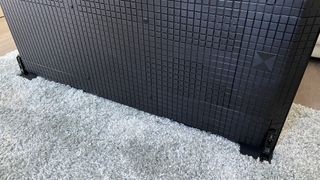
(Image credit: Future)
The tone of the sound is rich and engaging too, with no harshness at the top-end or buzzy, phutty, distorted bass at the other. Instead you get an open, lively, wide-ranging mid-range that never does anything nasty to distract you from what you’re watching.
The twin bass woofers on the A95K’s rear attach their low frequency sounds to the lower-end of the screen’s main sound extremely tidily too, so that bass doesn’t sound baggy or detached. And again, except at volumes well beyond anything most people would consider comfortable, the bass drivers avoid losing their composure or dropping out.
Dialogue is credible with voices, always intelligible and well contextualised. All in all, the A95K’s built-in sound is good enough to be not just a suitable accompaniment to the TV world’s best pictures, but a potentially credible centre speaker in a pretty serious external surround system.
Sony A95K review: Design and usability
(Image credit: Future)
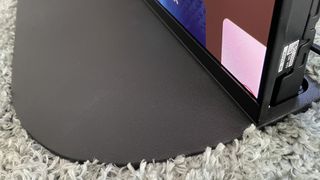
(Image credit: Future)
The A95K’s unusual design is, quite deliberately, reminiscent of Sony’s first-ever OLED TVs: the A1E series. This finds the screen sitting right down on a heavy black metal plate-style stand that runs the full width of the screen (making it tricky to place a soundbar underneath it if you’re not satisfied with the TV’s audio system).
You can choose whether you want to attach the screen to the front or back of its stand plate. Personally we suspect most people will prefer the cleaner look you get with the screen attached to the base’s front, but if your living room isn’t very big it could be handy to be able to place the screen at the back of the stand so that it can be pushed right up to your wall.
(Image credit: Future)
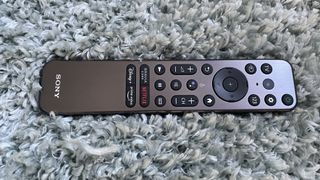
(Image credit: Future)
Sony’s reliance on Google TV for its smart systems doesn’t make the A95K particularly easy to use. While Google TV is more attractive and a bit more customisable than its Android TV predecessor, its full-screen interface and sometimes dictatorial-feeling approach to content curation can make getting to the stuff you actually want to watch a bit of a chore. The way the smart interface ties in with the picture and sound set-up menus can be confusing too.
Sony A95K review: Verdict
(Image credit: Future)
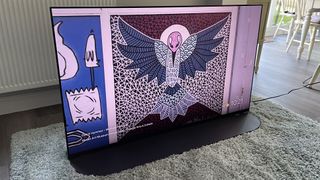
(Image credit: Future)
Sony’s 2022 flagship TV isn’t perfect, but it’s very close. Let’s get the minor niggles out the way first: it can lose black level in very bright rooms; it’s only available in 55-and 65-inch versions, with no 77-inch model for home cinema fans; it sells for a hefty premium over Samsung’s rival QD-OLED S95 model; and we guess it feels more like a step up from regular OLED TVs rather than a quantum leap.
Also consider
Samsung’s S95Bis the closest direct rival to Sony’s A95K, in that it also uses new Quantum Dot OLED technology. It pushes the technology’s brightness and colour advantages harder than the Sony does, but while this can deliver more eye-catching results, its images are also more prone to inconsistency and moments of not looking very natural. The S95B’s audio is nowhere near as good as that of the 55A95K either.
Today’s best Sony A95K QD-OLED TV, Samsung S95B 55-inch, LG G2 OLED and Philips 55OLED+907 dealsLow StockSony XR-A95K$2,798ViewSee all pricesLG Gallery G2 OLED$1,915ViewSee all pricesWe check over 250 million products every day for the best prices
Today’s best Sony A95K QD-OLED TV, Samsung S95B 55-inch, LG G2 OLED and Philips 55OLED+907 dealsLow StockSony XR-A95K$2,798ViewSee all pricesLG Gallery G2 OLED$1,915ViewSee all pricesWe check over 250 million products every day for the best prices
Today’s best Sony A95K QD-OLED TV, Samsung S95B 55-inch, LG G2 OLED and Philips 55OLED+907 dealsLow StockSony XR-A95K$2,798ViewSee all pricesLG Gallery G2 OLED$1,915ViewSee all pricesWe check over 250 million products every day for the best prices
Today’s best Sony A95K QD-OLED TV, Samsung S95B 55-inch, LG G2 OLED and Philips 55OLED+907 deals
Low StockSony XR-A95K$2,798ViewSee all pricesLG Gallery G2 OLED$1,915ViewSee all prices
Low StockSony XR-A95K$2,798ViewSee all prices
Low Stock
Low Stock
Low Stock
Low Stock
Low Stock
Sony XR-A95K$2,798ViewSee all prices

Sony XR-A95K
Sony XR-A95K

$2,798View
$2,798
$2,798
See all prices
LG Gallery G2 OLED$1,915ViewSee all prices
LG Gallery G2 OLED$1,915ViewSee all prices

LG Gallery G2 OLED
LG Gallery G2 OLED

$1,915View
$1,915
$1,915
See all prices
We check over 250 million products every day for the best prices
We check over 250 million products every day for the best prices
TOPICSsony
TOPICS
Sign up to the T3 newsletter for smarter living straight to your inbox
Get all the latest news, reviews, deals and buying guides on gorgeous tech, home and active products from the T3 experts

My most anticipated Apple TV+ show gets another tantalising teaserThe Studio gets a minute tease
The Studio gets a minute tease

Build bigger arms in just 30 minutes with this 5-move dumbbell-only workoutIt’ll leave the biceps and triceps popping!
It’ll leave the biceps and triceps popping!

OMEGA puts the moon on your wrist with its new Speedmaster Moonphase MeteoriteOMEGA adds two new Moonphase Meteorite watches to its Speedmaster line-up
OMEGA adds two new Moonphase Meteorite watches to its Speedmaster line-up